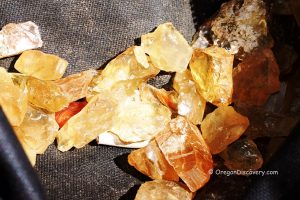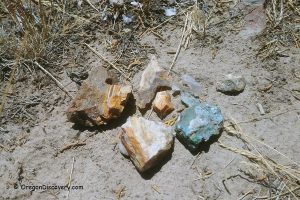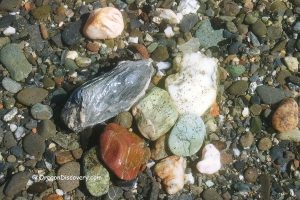
Petrified wood, type of fossilized wood, is mineralized remnants of ancient trees dating back to the Late Paleozoic to the Cenozoic eras, roughly between 250 million to 2 million years ago. The term "Petrified" is derived from the Greek word "Petro", meaning "stone", signifying the transformation of wood into stone.
This long-term process, known as petrification, can take anywhere from hundreds to millions of years, during which the wood structure is completely transformed into minerals. The time required for wood to become petrified depends on various factors, including the mineral concentration in the groundwater.
The wide variety of colors found in petrified wood is a result of mineral impurities present during the petrification process. Here are the types of petrified wood:
- Agatized wood: Wood that has been replaced, cell by cell, by chalcedony, jasper, or agate.
- Opalized wood: The original structure of the wood has been replaced by opal.
- Silicified wood: The cellular structure of the wood has been replaced by any form of silica, including opal and agate.
Formation of Petrified Wood
Petrified wood can form from ancient walnut, Myrtlewood, sycamore, and birch trrees. The petrification process involves the gradual mineralization around organic material by quartz crystals such as agate, jasper, amethyst, opal, or citrine.
This process often occurs when ancient trees are buried in sediments mixed with volcanic ash in an anaerobic (oxygen-free) environment. Silica from the volcanic ash is dissolved in groundwater, which is then absorbed by the porous wood. Over time, the wood tissue is filled totally with minerals, preserving the wood remarkably well and allowing us to recognize fine details such as growth rings, veins, and bark.
Limb Casts
If the wood structure decays or burned out before replacement, wood can be formed as limb casts. During this process, the limb-shaped cavity is filled with chalcedony and other minerals from groundwater, completely occupying the space left behind. As a result, the interior of the limb cast does not preserve the fine details of the tree, but the outer surface may still show bark or wood knots.
How to Identify Petrified Wood?
Larger pieces of petrified wood are easily identifiable if the specimen retains its original shape and structural details. Here are some tips for identification:
- Look for the circular structure of annual rings on either end of the piece.
- Check if the surface of the specimen resembles tree bark.
Identifying petrified wood can be challenging if the specimen is small or if its inner structure has been lost (as in limb casts). Some small pieces of petrified wood can resemble agate, but agate typically exhibits a more rounded shape.
Petrified Wood Color
The colors of petrified wood are influenced by the presence of various minerals:
- Black: Carbon and manganese
- Green and blue: Cobalt, chrome oxide, and copper
- Yellow, red, and brown: Iron oxide
- Pink and orange: Manganese
- Yellow: Manganese oxide
- White: Silicates of aluminum
Where to Find Petrified Wood?
Oregon is known for many locations where you can find petrified wood and legally collect it for your collections. Fossilized wood can be found on gravel bars of rivers, reservoir and lake shorelines, ocean beaches, fields, quarries, and designated public collecting sites.
 Bear Creek
Bear Creek
Bear Creek Rockhounding Area is well-known for the abundance of petrified wood. This location is designated by Bureau Land of Management as a recreational rockhounding area.
 Hampton Butte
Hampton Butte
Hampton Butte is popular among rock collectors for its unique green petrified wood. The 120-acre rockhounding area is located 12 miles northeast of Highway 20 near the community of Brothers.
Where to Find Limb Casts?
Limb casts are found in public rockhounding areas of Central Oregon near unincorporated communities of Crook County Post and Paulina.
 Dendrite Butte
Dendrite Butte
Dendrite Butte is known for its limb casts with blue, pink, and green shades. Covering 540 acres, Dendrite Butte is designated by the Bureau of Land Management as a recreational rock and mineral collecting site.
 Congleton Hollow
Congleton Hollow
Within the expansive 640 acres of this rockhounding haven, a splendid opportunity awaits enthusiasts to discover opalized petrified wood and limb casts with pink, blue, and green hues.
How Many Petrified Wood I Can Collect?
Collecting petrified wood on public land in the United States is allowed for personal use, which means you cannot sell it. According to BLM regulations in Oregon and Washington, you are allowed to collect up to 25 pounds of petrified wood per day, plus one piece, with a maximum of 250 pounds per year. Quotas between two or more people may not be pooled to obtain pieces larger than 250 pounds.
The U.S. Forest Service limits collections to 10 pounds. Some lands within the National Forest are closed to collecting due to wilderness designation. Always check with the BLM or U.S. Forest Service for up-to-date regulations and specific locations.
For more information on rockhounding regulations in Oregon, contact BLM or U.S. Forest Service for up-to-date information.
Read more about Rockhounding Regulations and Rules on public lands of the state of Oregon.
You May Also Like
Gems and Minerals in Oregon. Oregon Department of Geology and Mineral Industries. OD http://www.oregongeology.org.
Dan R. Lynch, Bob Lynch. Rocks & Minerals of Washington and Oregon: A Field Guide to the Evergreen and Beaver States (Rocks & Minerals Identification Guides). 2012.












